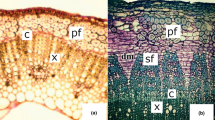Summary
Gut extracts of Gammarus fossarum liberated reducing substances (at pH values ≤7) and amino acids (pH≥7) from freshly shed oak leaves only after removal of soluble leaf phenols. When carboxymethylcellulose was used at a concentration equal to that of leaf cellulose, release of reducing substances was considerably higher. Fungal enzymes extracted from decomposing leaves were active against structural carbohydrates but showed no proteolytic activity. At low pH values, they retained their full activity in the presence of gut enzymes of G. fossarum, at higher pH values they were inhibited. Conditioned leaves released larger amounts of reducing substances and amino acids when exposed to gut enzymes. The improvement varies with the fungal species used for conditioning and with the length of the conditioning period. The digestibility of leaf carbohydrates and proteins reached separate peaks and then declined. Fungal carbohydrases ingested by G. fossarum retained some activity for up to 4h.
Similar content being viewed by others
References
Bärlocher F (1981) Fungi on the food and in the faeces of Gammarus pulex. Trans Br mycol Soc 76:160–165
Bärlocher F, Kendrick B (1975a) Leaf-conditioning by microorganisms. Oecologia (Berl) 20:359–362
Bärlocher F, Kendrick B (1975b) Assimilation efficiency of Gammarus pseudolimnaeus (Amphipoda) feeding on fungal mycelium or autumn-shed leaves. Oikos 26:55–59
Bärlocher F, Kendrick, B (1981) The role of aquatic hyphomycetes in the trophic structure of streams. In: The fungal community: its organisation and role in the ecosystem GC Carroll and WT Wicklow (eds), Marcel Dekker, New York, p 743–760
Bjarnov N (1972) Carbohydrases in Chironomus, Gammarus and some Trichoptera larvae. Oikos 23:261–263
Cummins KW, Klug MJ (1979) Feeding ecology of stream invertebrates. Ann Rev Ecol Syst 10:147–172
Kaushik NK, Hynes HBN (1971) The fate of the dead leaves that fall into streams. Arch Hydrobiol 68:465–515
Kristensen JH (1972) Carbohydrases of some marine invertebrates with notes on their food and on the natural occurrences of the carbohydrates studied. marine Biology 14:130–142
Luxton M (1972) Studies on the oribatid mites of a Danish beech wood soil. Pedobiologia 12:434–463
Martin MM, Martin JS (1978) Cellulose digestion in the midgut of the fungus-growing termite, Macrotermes natalensis: the role of acquired digestive enzymes. Science 199:1453–1455
Martin MM, Martin JS, Kukor JJ, Merritt RW (1980) The digestion of protein and carbohydrate by the stream detritivore, Tipula abdominalis (Diptera, Tipulidae). Oecologia (Berl) 46:360–364
Merritt RW, Cummins KW (1978) An introduction to the aquatic insects of North America. Kendall-Hunt, Dubuque, Iowa
Monk DC (1976) The distribution of cellulase in freshwater invertebrates of different feeding habits. Freshwat Biol 6:471–475
Monk DC (1977) The digestion of cellulose and other dietary components, and pH of the gut in the amphipod Gammarus pulex L. Freshwat Biol 7:431–440
Moore JW (1975) The role of algae in the diet of Asellus aquaticus L. and Gammarus pulex L. J Anim Ecol 44:719–730
Nelson N (1944) A photometric adaptation of the Somogyi method for the determination of glucose. J Biol Chem 153:375–380
Nielsen CO (1962) Carbohydrases in soil and litter invertebrates. Oikos 13:200–215
rosen H (1957) A modified Ninhydrin colorimetric analysis for amino acids. Arch Biochem Biophys 67:10–15
Rosset J, Bärlocher F, Oertli JJ (1981) Decomposition of conifer needles and deciduous leaves in two Black Forest and two Swiss Jura streams. Int Revue ges Hydrobiol: in press
Somogyi M (1952) Notes on sugar determination. J Biol Chem 195:19–23
Suberkropp K, Godshalk GL, Klug MJ (1976) Changes in chemical composition of leaves during processing in a woodland stream. Ecology 57:720–727
Suberkropp K, Klug MJ (1976) Fungi and bacteria associated with leaves during processing in a woodland stream. Ecology 57:707–719
Suberkropp K, Klug MJ (1980) The maceration of deciduous leaf litter by aquatic hyphomycetes. Can J Bot 58:1025–1031
Swain T (1979) Tannins and lignins. In: GA Rosenthal, DH Janzen (eds). Herbivores: their interaction with secondary plant metabolites. Academic Press, New York, p 657–682
Van Sumere CF, Albrecht J, Dedonder A, de Pooter H, Pe I (1975) Plant proteins and phenolics. In: JB Harborne, CF Van Sumere (eds). The chemistry and biochemistry of plant proteins. Academic Press, New York, p 211–264
Author information
Authors and Affiliations
Rights and permissions
About this article
Cite this article
Bärlocher, F. The contribution of fungal enzymes to the digestion of leaves by Gammarus fossarum Koch (Amphipoda). Oecologia 52, 1–4 (1982). https://doi.org/10.1007/BF00349003
Received:
Issue Date:
DOI: https://doi.org/10.1007/BF00349003




